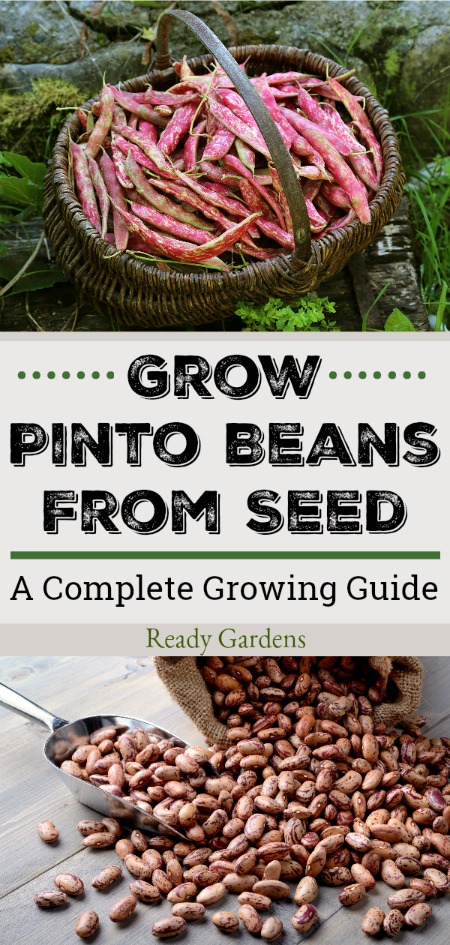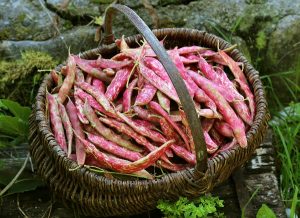If there’s one type of bean the entire family loves, it’s the pinto bean. In Spanish, the word “pinto” means painted [1] and these beans are appropriately named because their outer skin is a spotted, swirling, red-dotted masterpiece of color. But inside is what counts, and they have a rich creamy texture perfect for soups and stews on those upcoming cold winter nights.
Pinto beans also have nutritional benefits that help boost heart health and could help the body fight off cancer. Pinto beans contain antioxidants called polyphenols [2], which may prevent some forms of cancer, according to the American Journal of Clinical Nutrition. [3] Pinto beans also contain kaempferol, which is a flavonoid [4] known to help reduce inflammation. These beneficial antioxidants may slow the growth of tumors while increasing the survival rate of much-needed healthy cells. Not only that, but other studies have found there are benefits to eating foods that contain kaempferol. These foods help reduce the risk of developing cancer. This is the result of the anti-inflammatory and antimicrobial properties making the pinto bean a great food for possibly preventing and even treating, some diseases; possibly even cancer.
Just one cup of pinto beans contains 41 grams of protein! Although high in carbohydrates, pinto beans are jam-packed with other nutrients! (Click here for the full list of nutritional content.) [5] So why not try to grow some healthy and delicious pinto beans in your garden? The added bonus is that most kids love pinto beans and it usually isn’t too hard to get them to eat these beans!
Helpful Tip: pinto beans take about 90-150 days to grow as a dry bean but can be harvested earlier and eaten as a green snap bean.
BEFORE PLANTING
- Pintos need long, warm summers with full sun exposure of at least 6 hours per day.
- Do not plant pinto beans where other beans have been growing for at least 3 years, as they may be susceptible to disease.
- Beans, in general, do not do well when transplanted so it’s best to direct sow the seeds. Do not plant them too early or they will rot in cool, damp soil.
- Pinto beans do well as companion plants with cucumbers, celery, and strawberries. Although they taste great when combined, avoid companion plantings alongside onion, garlic, and fennel.
- Before planting, soak the beans overnight.
PLANTING
- Beans take a long time to mature. [6] Speed up the process by laying down black plastic to keep the soil warm. You can also grow pinto beans in containers indoors to be moved outside once temperatures warm up enough.
- Grow in well-draining, fairly fertile soil with a pH of 6.0-7.0.
- Work in compost prior to planting to reduce the need to fertilizer.
- The eye of the bean should be facing downward, planted at a depth of 1-½ inch, 4-6 inches apart with at least 2 feet between rows when growing pinto beans.
- Water the seeds in well and keep moist.
- Germination should occur between 8-14 days provided temperatures are between 70-80 degrees F. (21-26 C.)
- Thin the seedlings to 6 inches apart.
- Keep the area around the beans free of weeds but do so carefully lest you disturb the roots.
- Feed the beans with some compost tea halfway through the growing season. Other than that, it is generally unnecessary to fertilize pinto beans.
TROUBLESHOOTING
Seedlings are deformed or have no growing tips or leaves when they emerge: Seedcorn maggots are the small yellowish-white larvae of small gray flies and could be the culprit. Cultivate to expose the larvae and disturb the life cycle. Replant when the weather is warmer and keep the garden clean.
Seedlings are stunted and never recover: Cold soil and weather can weaken seedlings that do emerge too early. The soil temperature is likely below 60°F. Pull up the seedlings, warm the soil with black or clear plastic, and sow new seed.
Seedlings and plants stunted; leaves yellowed and distorted: Thrips are tan to black bugs that look like slivers of wood; Thrips feed on plants, rasping plant tissue. Seedlings are the most affected. Plants will outgrow and recover thrip attack.
HARVESTING
It will take about 90-150 days (depending on the weather) to harvest. Pintos can be harvested when they are still green [7] and immature, but most people choose to leave them on the vine until they dry out. At this point, they will be firm and the thickness of a pencil. You can try to bite the bean, and if your teeth barely leave a dent, it’s hard enough to pick.
When mature, the pods will be green, plump looking and approximately 4 to 6 inches long. Bush pinto beans mature all at once, but pole beans are harvested on a continuous basis which encourages additional production for a month or two. To harvest pinto beans, gently pull or snap off the vine. If you are growing for dry beans, be sure the plants have plenty of space between them to allow the pods to dry completely. If you get a late rain and the pods are mature, pull the entire plant from the ground and hang it in a dry place to continue to desiccate.
Withhold water from the pinto bean plants for two weeks before the time you plan to harvest. The pods should start to turn yellow. Withholding water will quicken the drying process. [7]
STORAGE
Shell the fresh pinto beans as soon as possible after they are harvested. To shell, open the bean pod by pulling the string located on the top of the pod. The pod should open, revealing two to five beans. If you cook the beans fresh, store them in a plastic bag and place in the freezer. Store the dried beans in an airtight container, jar, or plastic bag. Place the beans in a cool, dry area until they are ready for use.
Now that you’ve got some delicious pinto beans ready to use, get creative! Create some soul-warming soups and stews to help stave off the cold this winter!

